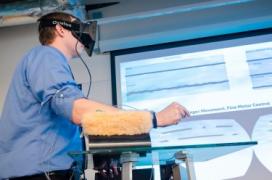The student developers of vHAB, a videogame that motivates patients to work harder when in rehabilitation for stroke and traumatic injury, have successfully launched their start-up company and begun early market testing. vHab was developed at the Center for Sensorimotor Neural Engineering (CSNE), an ERC based at the University of Washington.
Motivating patients in often difficult and even painful rehabilitation remains a hurdle to speedy recovery. Getting vHAB to market ensures that the technology can begin to help patients more quickly to regain their health. vHAB, or virtual rehabilitation, records movement and muscle activity to provide real-time feedback to patients and clinicians. vHAB is constructed from off-the-shelf technologies and unique software tailored to individuals suffering from upper extremity impairment. It relies on an Oculus Rift virtual reality headset and a Leap Motion device, for which the team developed a series of games emulating therapy tasks. One game has players build a pizza, another has them brush a giant’s teeth. The game utilizes the levels and sense of accomplishment that can make video games addictive, which in this case drives patients to work harder and longer toward their recovery.
vHAB won the 2014 Tech Sandbox competition at the CSNE in Seattle. The team—Tyler Libey and Brian Mogen (graduate students), Lars Crawford and Tanner Dixon (undergraduate students)—created their game for people recovering from a stroke, traumatic brain injury, or similar condition. The CSNE spurred the team’s work on vHAB, and provided resources and incubation space as developers explored options for their pioneering product.


